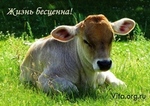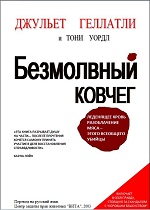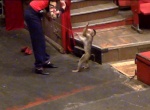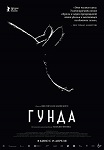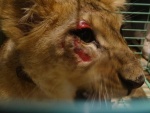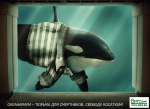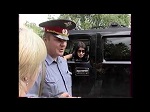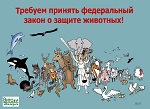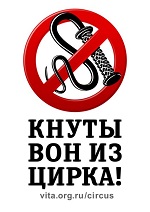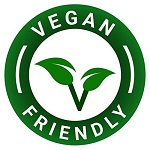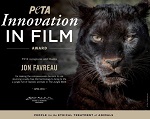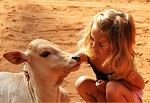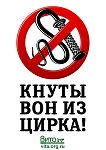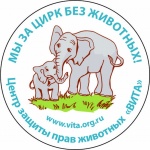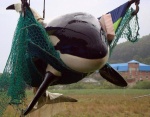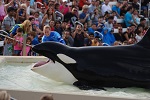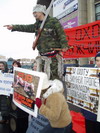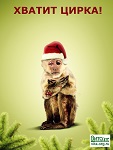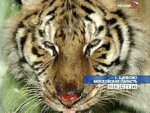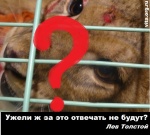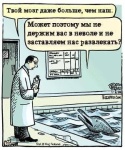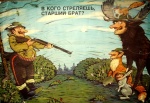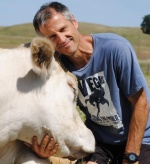|
Письмо главы Всемирного общество защиты животных WSPA Питера Дэвиса к Слиске Л.К.
Питер Дэвис, глава Всемирного общества защиты животных WSPA - самой крупной в мире организации по защите животных, объединяющей сотни зоозащитных организаций по всему миру, направил обращение к российским властям с просьбой принять закон в защиту животных от жестокого обращения.
"WSPA получает множество жалоб на жестокое обращение с животными в России - пишет Питер Дэвис в обращении, направленном Путину В.В. и Слиске Л.К. - Мы были разочарованы, узнав, что 245 статья УК РФ, призванная защищать животных от жестокого обращения, практически не работает, а милиция не всегда знает о её существовании".
По словам Константина Сабинина, члена Совета Центра защиты прав животных "Вита" - организации, входящей в состав WSPA, - "Животные России находятся в абсолютно бесправном положении. Например, в г. Плюсcа (Псковская область) из-за бездействия правоохранительных
органов живодёры, убившие собаку при помощи бензопилы остались
безнаказанными. В течение 2 лет владелец собаки, общественность
и российские звёзды неоднократно взывали к прокурору с требованием
привлечь виновных по 245 ст. УК РФ за жестокое обращение с животными. Однако, дело было закрыто "за отсутствием состава преступления".
Центр защиты прав животных "Вита" неоднократно обращался к российским
властям с просьбой принять Федеральный закон о защите животных
от жесткого обращения. Пять лет назад закон прошёл Госдуму и Совет
Федерации, но впоследствии был отклонён, что способствовало росту
преступности, связанной с использованием животных в различных
сферах и усугублением бесправного положения российских животных.
Правовой пробел в этой сфере привёл к тому, что чудовищные по
своей жестокости преступления в отношении животных, сегодня остаются
безнаказанными. Это порождает бесчисленное количество жалоб россиян
в Генеральную прокуратуру, Верховный Суд РФ, МВД и другие министерства
России. Однако, в отсутствии полноценного законодательства, проблемы,
по которым обращаются люди, остаются не решаемыми.
"Проблема отсутствия
в России закона в защиту животных волнует не только борцов за
права животных и сердобольных граждан. Год назад к президенту
РФ с открытым письмом обратились 106 народных артистов России,
которые просили главу государства принять многострадальный Федеральный
закон о защите животных. Однако, ответ, присланный администрацией
президента, иначе, как отпиской, назвать нельзя" - считает К. Сабинин.
Законодательство
Информационный бюллетень "Виты" № 11. 2005 год
Рекомедации по разработке законодательных актов в защиту животных,
разработанные WSPA
ANIMAL PROTECTION
LEGISLATION
GUIDANCE NOTES AND SUGGESTED PROVISIONS
August 2004
ANIMAL PROTECTION LEGISLATION
GUIDANCE NOTES AND SUGGESTED PROVISIONS
CONTENTS Page
Section 1:
Introduction 3
Section 2:
Guidance notes 5
Section 3:
General provisions 10
Section 4:
Suggested provisions for farm animals 13
Section 5:
Suggested provisions for animals used in experiments 27
Section 6:
Suggested provisions for companion animals 35
Section 7:
Suggested provisions for animals used in entertainment 41
Section 8:
Further information 44
SECTION 1
INTRODUCTION
Animal protection legislation
The World Society for the Protection of Animals (WSPA) aims to
promote the laws and enforcement structures designed to provide
legal protection for animals.
It is the belief of the WSPA that every nation should have comprehensive
animal protection legislation. Animals are sentient creatures,
and therefore entitled to recognition as such, and to care and
protection against avoidable suffering. The degree of cultural
maturity of a society is reflected in its attitude towards its
animal population. It is widely recognized that the abuse and
exploitation of animals is not only detrimental to the health
and welfare of the animals concerned, but also harmful to the
moral and spiritual development of the human population.
WSPA's guidance notes and suggested legislative provisions
The WSPA has prepared these legislative guidelines for countries
wishing to introduce animal protection legislation or to improve
their existing provisions.
These guidance notes are based on WSPA's experience of the introduction
of animal protection legislation in a number of countries, and
attempt to highlight areas commonly causing difficulties in this
process.
The suggested legislative provisions are derived from a comparative
study of some of the most progressive animal protection laws already
in existence.
What is the WSPA?
The World Society for the Protection of Animals (WSPA) is an international
non-governmental organization and the largest animal protection
federation. It was founded in 1981 as a merger of the World Federation
for the Protection of Animals (WFPA: founded in 1950) and the
International Society for the Protection of Animals (ISPA: founded
in 1959).
The WSPA is working to raise the standards of animal welfare throughout
the world.
Our campaigns and projects are developed in partnership with over
450 member societies throughout the world, whose local skills
and knowledge are vital to achieving a better environment for
animals.
Our vision is to ensure that the principles of animal welfare
are universally understood and respected, and that they are protected
by effectively enforced legislation.
The WSPA provides technical expertise, guidance and assistance
to promote animal welfare world-wide, and liaises with government
officials to introduce animal protection legislation or to enforce
existing laws.
The WSPA has consultative status with the United Nations, it is
an official observer at the Council of Europe, and has a high
profile in many other inter-governmental organisations.
The WSPA drafted the originating document on which the Council
of Europe's welfare conventions were based, and it still contributes
a major input into the animal welfare work of the Council.
What are WSPA's beliefs?
The ethical basis for the WSPA's policies is that it looks beyond
the conservation of a species to the welfare of individual animals.
It is WSPA's belief that each individual has an intrinsic value,
and should therefore be respected and protected.
Animals have biologically determined instincts, interests and
natures, and can experience pain. Thus the WSPA believes that
animals have the right to live their lives free from avoidable
suffering at the hands of humans, rather than be used simply as
'raw materials' for the benefit of mankind. Indeed, the WSPA believes
that it is the duty of humans to provide for the welfare of other
species.
The WSPA believes that all animals kept by, or under the control
of humans must be kept in circumstances appropriate to their species.
Furthermore, where the physiological and behavioural needs of
a species cannot be met, then the species in question must not
be kept by man.
The WSPA believes that where the welfare of an animal under human
control is in question, the animal must be given the benefit of
any doubt. Furthermore, the different purposes for which animals
are used must be regularly re-evaluated.
SECTION 2
GUIDANCE NOTES
Introduction
These notes provide a brief and easily accessible reference to
key considerations when formulating a legal framework for animal
protection. Each country will need to take full account of its
particular national situation in addition, and its existing and
planned obligations in this field (e.g. international or regional
conventions to which it has acceded, or intends to accede).
International conventions
At the moment there is no international agreement concerning the
care of animals. The one region where agreements have addressed
the concerns of animals is in Europe. While these are certainly
a step forward, they have the inherent limitation of being restricted
only to Europe. However, they represent an important depositary
of ideas concerning how to place animal issues in an international
law context.
European conventions/ legislation
The Council of Europe (COE) has five animal welfare conventions,
which cover: -
" Farm Animals
" Transport
" Slaughter
" Animal Experimentation
" Pet (Companion) Animals
Furthermore, there are various recommendations under these conventions.
A summary of these conventions is available from the WSPA on request.
The WSPA's suggested legislative provisions take into account
key Council of Europe provisions.
Some animal welfare legislation also exists at the European Union
(EU) level. The main areas covered by this legislation are: -
" Transport
" Slaughter
" Egg-Laying Hens
" Veal Calves and Pigs
" Experimentation
" Drift Netting
" Seals
" Fur Trapping
" Conservation/Wild Birds
" Zoos
Enhancing animal protection
To improve the status of animals in any country, the WSPA suggests
that: -
(1) Legal provisions be developed to ensure the humane treatment
of animals by human beings in any area in which humans have the
potential to abuse, exploit or otherwise cause unnecessary suffering
or injury to animals.
(2) Humane education programmes be established to teach respect
for animals, to focus on their intrinsic value, and to nurture
responsible stewardship.
(3) Encouragement and assistance be given to voluntary humane
societies as one way of promoting the humane ethic.
Legislation alone is insufficient to bring about a real change
in the attitudes and practical protection afforded to animals.
To be really effective, it needs both the popular support of a
humane, caring society and proper enforcement.
Legislation aims and objectives
In drafting protective legislation, it can be helpful to include
the reasons why the legislation is being introduced. Key reasons,
such as the sentiency of animals, their capacity for suffering,
the moral and spiritual decline caused by cruelty, the development
of societies, the degree of cultural maturity etc., which have
been set out earlier in this publication, could be incorporated.
The 'preamble' of the law would be the appropriate place to include
the purpose/objectives of animal protection legislation.
Definitions
Legal definitions are the core of animal protection legislation
as they define the outer parameters/boundaries of protection.
For example, what is an 'animal' (does the definition exclude
invertebrate species, should wild animals be included or human
species specifically excluded?). There have been many different
definitions of the word 'animal', and the consequences of the
chosen definition should be given careful consideration. According
to the British Secretary of State's Standards of Modern Zoo Practice,
'animal' means any mammal, bird, reptile, amphibian, fish, insect
or other multi-cellular organism that is not a plant or fungi.
What constitutes cruelty? - Should terms such as 'unnecessary
suffering' be used, and if they are, should these be defined to
avoid any doubt? If inspection is envisaged, what/who is an inspector?
Whenever a term is used which has no accepted definition (especially
where this has not been determined under law), a specific definition
should be considered. The early definition of all key terms will
facilitate interpretation and enforcement.
Level of legislation
The individual country's legislative structure will need to be
taken into account when assessing the best approach for the draft
law.
Constitution
Not all countries have a written constitution. However, where
a written constitution does exist, it would be a good objective
to include the principle of animal protection into the constitution.
This may be more acceptable politically if it is linked to environmental
protection - a move that would be supported by a powerful lobby
of animal protection and environmental organizations and supporters.
Primary legislation
Outlines general principles, defines areas to be covered by subsequent
detailed regulations, identifies the government department (or
other body) responsible for subordinate/secondary legislation
etc. i.e. It sets down the guiding principles and leaves detailed
provisions for the specified government departments to elaborate.
Subordinate/ secondary legislation
Detailed regulations covering a specific area. To be formulated
by relevant government departments on the basis of expert advice,
and consultations with interested parties.
Working instructions
Apart from the legislation, it may be helpful to formulate both
working instructions for those enforcing the legislation (i.e.
inspector's instructions) and "codes of conduct" (i.e. guidelines
for those needing to comply with the legislation). Reference to
the codes of conduct can form an integral part of the legislative
and enforcement process.
The issue (and acknowledgement of receipt) of an appropriate code
of conduct giving detailed advice on the care/protection of animals
leaves the individual who has responsibility for the animals with
no defence against any subsequent charge of causing suffering.
If that person has not complied with the code of conduct, then
they can be judged as lacking 'due diligence'.
Formulation of provisions/ consultation
Detailed provisions in the legislation should be formulated in
consultation with all interested parties (i.e. including industry,
inspectors, animal welfarists and consumers, as appropriate).
In this way, impractical provisions and areas of conflict can
be resolved before the law is introduced. This is vital, because
any legislation is likely to be unenforceable unless it is deemed
to be fair. Technical assessment and specialist advice, for example,
scientific or veterinary, should be obtained and used wherever
appropriate. In areas where ongoing consultation is envisaged,
a permanent advisory body can be constituted, and this could be
provided for in the legislation itself.
Enforcement
Who will be responsible for enforcing the legislation? This could,
for example, be central government, regional or local government,
or an animal protection society.
Will the same body be responsible for enforcing prosecution charges?
The enforcing agency should be clearly stated in the legislation,
together with the extent of their powers, and the necessary provisions
for cost/expenses of enforcement. It may also be wise to provide
a duty to enforce. A dedicated animal welfare inspectorate is
considered the best option, to allow for specialisation and expertise,
and to prevent welfare duties being overlooked in favour of other
pressures.
Powers
Powers should be granted in the legislation and clearly defined.
For example, enforcement officers should be given powers to take
remedial action (e.g. to arrange for treatment or, where necessary,
euthanasia in case of suffering), and of confiscation of relevant
documentation. Also, consideration should be given as to whether
they should be given the power to detain people and vehicles,
and on what grounds.
Enforcement officers should be given powers of entry, allowing
them to enter upon any land or premises for the purpose of ascertaining
whether an offence has been committed.
Phase-out periods
Where unsuitable housing systems (such as veal crates and battery
cages) or equipment, are to be phased out, the phase-out period
permitted should be no longer than the period the tax authorities
allow farmers and agriculturists for depreciation of their capital
investment. The phase-out period would only apply to existing
systems, since the manufacture, sale, purchase and use of such
new systems would be forbidden (apart from the existing stocks
available for sale, which would fall under phase-out arrangements).
Penalties
Levels of penalties should be established both for deterrent purposes
and to ensure uniform application, and the channel of legal action
should be defined (i.e. the level of court). Types of penalties
could range from fines to imprisonments and a ban from keeping
animals and/or revocation of the relevant licence. There would
also need to be a provision for assuming custody and removing
animals in danger of cruelty/suffering pending legal action.
Ethical/ advisory committee for animal protection
An ethical committee should be established as a consultancy institution.
Its function would be to educate society and to give recommendations
regarding animal protection to public institutions. It should
be composed of representatives of public and research institutions
and of non-governmental organisations.
Aims and objectives of an ethical/advisory committee:
1. The provision of advice on the welfare of animals and the publication
of their findings;
2. The furtherance of a fuller understanding of animal welfare
within society;
3. The assessment of existing legislation affecting animal welfare
and the making of recommendations regarding amendments and additions
thereto.
In furtherance of these objectives, the committee will:
1. Undertake independent and objective studies of animal welfare
issues and identify where further information is required;
2. Prepare and publish reports;
3. Make available information and research datathat has been obtained,
in order to enable Parliamentarian legislation on animal welfare
issues to be drafted and debated;
4. Be open to requests for objective views, advice and the carrying
out of independent studies concerned with the welfare of animals;
5. Keep new issues and developments of concern in the sphere of
animal protection under review.
Various working groups can be formed within the committee/ council
with specialized knowledge in the following areas:
a) Farm Animals
b) Companion (Pet) Animals
c) Wild Animals
d) Experimental Animals
SECTION 3
GENERAL PROVISIONS
Introduction
The following General Provisions apply to all animals. More detailed
provisions on animals used for particular purposes, such as farm
animals, appear in later sections. The purpose of the General
Provisions is to ensure that a country's legislation includes
certain fundamental provisions.
Paragraphs 1-4 establish a number of basic safeguards: owners
and keepers are made responsible for animals' health and welfare,
and are required to provide for their core needs of food and water,
shelter, exercise and companionship. The suggested provisions
prohibit the causing of avoidable suffering, pain or distress
to animals as well as beating and overworking them.
Other valuable protections included in this section:
" Prohibit continuous or unnecessary restrictions on freedom of
movement if this involves suffering, pain or distress;
" Prohibit the use of animals for fighting;
" Require sick or injured animals to be provided with care without
delay;
" Regulate the carrying out of surgical operations; some of which
are prohibited altogether;
" Require the destruction of animals to be carried out as quickly
and painlessly as possible; some methods of slaughter are prohibited
altogether;
" Require animal attendants to be trained and certified.
Suggested legislative provisions
The following legislative provisions should be included to establish
basic protection for animal welfare:
1. Any person owning or keeping an animal shall be responsible
for its health and welfare.
2. Any person owning or keeping an animal shall provide accommodation,
care and attention, all of which take into account the animal's
physiological and behavioural needs, including appropriate food
and water, shelter, exercise, and companionship.
3. No person shall cause an animal avoidable suffering, pain or
distress.
4. No person shall beat, overload, overwork or overdrive an animal.
5. No person shall encourage, aid, attend/assist at or participate
in the fighting, baiting, harassing, or tormenting of animals.
No person shall breed, sell, or offer for sale animals for fighting
purposes.
6. Animals shall not be kept unless they belong to one of the
species or categories permitted by order of the competent authority.
7. The freedom of movement of an animal shall not be continuously
or unnecessarily restricted, if this entails suffering, pain,
or distress.
8. Any person keeping an animal shall ensure that the animal is
attended to at least once a day. Animals kept in extremely extensive
(range) conditions may need to be exempted from such a provision.
However, regular attention should still be required.
9. Sick or injured animals shall be provided with care without
delay. Where necessary, veterinary advice shall be sought. Where
euthanasia is necessary to relieve suffering, this shall be done
immediately by a qualified or competent person, and with minimum
suffering, pain and distress.
10. Any surgical operation which may inflict suffering on an animal,
except insignificant pain of a transient nature, shall be performed
only by a licensed/registered veterinarian. Suffering and pain
shall be reduced to the greatest possible extent.
11. Surgical and similar operations or painful procedures intended
to change the appearance of an animal shall not be performed;
nor shall operations or procedures altering or interfering with
the regular gait or stance of an animal be performed.
12. Other surgical operations on animals, in which part or parts
of the animal body is or are removed or damaged shall not be carried
out, unless: -
a) The operation is performed to neuter the animal;
b) The operation is performed simultaneously with the neutering
to remove the tip of the ear of a feral cat as a visible indication
that the animal has been neutered;
c) The operation is necessary for medical reasons;
d) The operation is permitted or prescribed by or in pursuance
of any legislative provisions; or
e) The operation is permitted and controlled by an order issued
by the competent authority.
13. Animals which have undergone a surgical operation prohibited
under paragraphs 11 or 12 above, shall not be kept in stock to
be sold, offered for sale, or bought.
14. Animals having undergone a surgical operation prohibited under
paragraphs 11 or 12 above, shall not be entered for shows, inspections
or competitions.
15. Any person who wishes to destroy an animal shall ensure that
it is destroyed as quickly and as painlessly as possible. Destruction
by drowning, hanging, beating, suffocation, poisoning or other
oral methods, or electrocution (as distinct from electronarcosis)
shall not take place. The competent authority shall lay down additional
regulations/instructions regarding methods to be used for 'pest'
control. These rules shall, however, take account of the general
provisions of this paragraph.
16. Any person driving or operating a vehicle or bicycle which
strikes or injures an animal shall, whenever possible, stop and
provide such care and attention to the animal as necessary to
relieve pain and aid its recovery. When the animal is a domestic
animal, such person shall use reasonable diligence to notify the
owner of the animal or the police.
17. International trade in live animals may only be carried out
under licence/permit from the competent authority. The competent
authority shall lay down rules on maximum journey times and conditions
for transport, as well as taking the necessary measures to protect
certain species (CITES implementation). International transport
shall be prohibited for species with particular welfare problems
in transit.
18. Wild animals shall not be kept without a licence/permit issued
by the competent authority.
19. Animals shall only be sold or given into the care of children
under the age of 16, if the person having custody of the child
gives his written consent and agrees to take supervisory control
of the animals' welfare.
20. The application of genetic engineering to animals or embryos
shall be prohibited. If this prohibition is not enacted, there
shall be a provision stipulating that animals resulting from genetic
engineering shall not be released on to farms or into the environment
until several generations have been evaluated to ensure that no
harmful side effects arise.
21. Patents shall not be granted on animals or processes for producing
animals.
22. Training for animal attendants and certification of ability
shall be implemented, covering animal behaviour, needs, keeping
and care (including handling). The competent authority shall lay
down the rules on training and certification.
23. Veterinarians shall always put the welfare of animals first,
regardless of any commercial or professional interest. A veterinarian
shall do his utmost at all times to safeguard the health and welfare
of animals.
24. The competent authority shall make regulations to:
a) Protect and regulate animals in the farming situation, including
animals in transport, slaughter and, if applicable markets;
b) Protect and regulate animals used for experimental purposes;
c) Protect and regulate companion (pet) animals;
d) Protect and regulate the use of animals for entertainment purposes
(including for display).
SECTION 4
SUGGESTED LEGISLATIVE PROVISIONS FOR FARM ANIMALS (INCLUDING IN
TRANSPORT AND IN SLAUGHTER)
Introduction
The first main section deals with welfare on the farm; subsequent
sections focus on the transport and slaughter of farm animals.
The provisions in the first section are designed to discourage
industrial farming (also known as factory farming), as this imposes
serious health and welfare problems on the animals involved. Where,
nonetheless, animals are farmed industrially, the section on "welfare
on the farm" aims to ensure that they benefit from certain safeguards.
This section recognizes that welfare problems can also arise in
extensive systems, and contains provisions designed to prevent
such problems.
The principles underlying this section are based on the Five Freedoms
which have traditionally been used as a framework for considering
animal welfare. These are, Freedom from hunger and thirst; Freedom
from discomfort; Freedom from pain, injury and disease; Freedom
from fear and distress; and Freedom to behave in a natural manner.
A core provision, from which much of the section flows, stipulates
that owners and keepers must provide animals with accommodation,
care and attention that takes account of their physiological and
behavioural needs, including appropriate food and water, shelter,
exercise and the companionship of other animals of their own species.
Following on from this principle, the suggested provisions prohibit
extreme restrictions of movement and require animals to be given
the freedom of movement that is appropriate to their physiological
and behavioural needs.
The section recognizes the important part played by housing systems
in determining the level of welfare. It also provides that the
Five Freedoms must be fulfilled, and in particular allow animals
to perform their natural behaviours.
The crucial importance of good stockmanship in attaining high
welfare standards is recognised by a requirement for all stockmen
to be trained and certified.
Suggested legislative provisions
General
1. Any person owning or keeping a farm animal (even temporarily,
such as in the role of a transporter or slaughterhouse) shall
be responsible for its health and welfare.
2. No person shall cause a farm animal any avoidable suffering,
pain or distress.
Welfare on the farm
Housing and care
1. Any person owning or keeping a farm animal shall provide accommodation,
care and attention in keeping with its physiological and behavioural
needs, including appropriate food and water, shelter, exercise
and companionship.
2. Any person keeping a farm animal shall ensure such animal is
attended to at least once a day. Animals kept in extremely extensive
(range) conditions may need to be exempted from such provisions,
but regular attention should nonetheless be stipulated.
3. With due regard to its species and in accordance with established
experience and scientific knowledge, the freedom of movement of
an animal shall not be restricted in such a way as to cause it
suffering, pain or distress. The animal shall be given the space
appropriate to its physiological and behavioural needs, particularly
where it is continuously or regularly confined or tethered.
4. Housing systems and installations for farm animals may only
be manufactured, advertised, marketed and sold if they have first
been licensed by the competent authority. The competent authority
shall only grant a licence to systems and installations that fulfil
the Five Freedoms, and in particular that allow animals to perform
their natural behaviours. The cost of this licensing procedure
shall be borne by the applicant. Housing systems and installations
shall only be licensed by the competent authority if all stipulated
requirements are adhered to, and it can be demonstrated that such
a system or installations will not adversely affect the welfare
of the animals they are intended for. A licence may be subsequently
revoked if any of the particulars furnished in the application
were subsequently found to be false, or if welfare problems become
apparent in the subsequent use that could not be overcome by adjustments
or alterations.
5. A prior approval system for housing systems and installations
is strongly recommended by the WSPA. However, should any country
given its current circumstances consider such a system unfeasible,
then at very least it should be stipulated that any new housing
systems and installations fulfil the Five Freedoms and, in particular,
allow animals to behave in their natural manner. This approach
could be further strengthened by the prohibition and phasing out
of inappropriate systems and installations; (for example, veal
crates for calves, sow stalls and tethers for pregnant pigs, battery
cages for egg laying hens).
6. The competent authority shall lay down a transitional period
during which housing and installations already on the market may
be sold.
7. Any premises or areas in which farm animals are kept shall
be designed and maintained in such a way as to satisfy the physiological
and behavioural needs of the animals (see provision 4 above).
In this regard, it shall be ensured that animals are given the
appropriate freedom of movement, particularly when digesting food
and water, and when resting. Furthermore, animals shall be protected
against wind and weather in accordance with their needs.
a. Consideration should be given to introducing a provision to
phase out battery cages. Rules concerning the design, operation
and use of alternative production systems should also be detailed.
b. Consideration should be given to introducing a provision to
phase out veal crates for calves.
c. Consideration should be given to introducing a provision to
phase out sow stalls (also known as sow gestation crates), tethers,
and farrowing crates.
8. Animals shall at all times be provided with a sufficient quantity
of straw, hay, wood shavings, rice husks or similar material to
enable them to engage in their natural behaviours and to act as
bedding or, litter for poultry. Fully slatted floors shall be
prohibited as they make it difficult to provide straw or the other
materials referred to above. Fully perforated floors shall also
be prohibited.
9. Detailed rules on the housing of farm animals should be elaborated
upon, including aspects such as:
a. The design and construction of pens, stables, cages and the
like.
b. The construction of the walls and flooring of pens, stables,
cages and the like, in particular focusing on the covering materials
to be used for these, bearing in mind the requirements of paragraph
8[the paragraph on straw etc]. The floors of housing must be easily
kept skid proof and dry. They must also satisfy the animals' warmth
requirements in the resting area.
c. The furnishings of pens, stables, cages and the like, in particular
the feeding and drinking water facilities, as well as the facilities
provided for animals to perform their natural behaviours.
d. The lighting, ventilation and heating/cooling systems of the
pens, stables, cages and the like.
e. The presence and nature of fencing.
10. In general, rules on the size of housing facilities should
be treated as minimum standards, otherwise they could become 'set
in stone', and mitigate against future beneficial improvements.
11. The technical equipment used in intensive stock-farming systems
shall be thoroughly inspected at least once a day, and any defect
remedied forthwith. All possible measures necessary to safeguard
the welfare of the animals shall be taken immediately.
12. As most animals are herd or flock creatures, they must not
be kept in isolation, but in appropriate social groupings. If
an enclosure is to be occupied by more than one animal, then the
enclosure must take account of group behavioural requirements.
Where appropriate to its needs, the possibility for an animal
to retreat, hide or avoid other animals must be available, including
fittings such as barriers, platforms, etc.
13. Farm animals shall not be continuously kept in the dark. Housing
in which animals are kept for all or most of the time shall, wherever
possible, be lit by natural daylight. Where this is not possible,
a suitable intensity and duration of light shall be provided.
The light phase shall not be artificially extended to more than
16 hours a day, or reduced to less than 12 hours.
14. No animal shall be provided with food or liquid in a manner,
nor shall such food or liquid contain any substance, which may
cause unnecessary suffering or injury.
15. Animals shall not be forcibly fed.
16. All animals shall be fed a balanced diet containing all essential
nutrients to assure the animals' good health and normal development
and behaviour. Animals shall be provided with a sufficient quantity
of food to prevent hunger. Clean water shall always be provided.
Calves shall be fed so that they receive sufficient fibrous food
and iron. Food additives that are detrimental to the animals'
health shall be prohibited.
17. Aquatic and semi-aquatic animals (including ducks and mink)
shall be provided with bathing water.
18. Where appropriate, breeding and laying animals shall be provided
with suitable nesting materials and nesting areas.
Non-therapeutic mutilations and invasive or surgical procedures
Introduction
Mutilations such as tail docking, castration and de-beaking are
commonplace, many of which are unnecessary. Farmers tail-dock
piglets to prevent tail biting and de-beak hens to prevent feather
pecking. However, scientific research shows that both tail biting
and feather pecking can best be prevented by keeping the animals
in good conditions, instead of by tail-docking and de-beaking.
Such mutilations should be prohibited, as should the castration
of piglets, lambs and many cattle. Strict regulations should be
placed on those mutilations that are permitted.
1. Consideration should be given to phasing out the de-beaking
of birds. In any event, no more than the tip of a beak should
be removed, if permitted, and any shortening of a beak to the
extent where the animal can no longer eat normally should be considered
an offence.
2. Consideration should be given to phasing out the tail-docking
of pigs. In any event, no more than the tip of the tail should
be removed.
3. The competent authority shall issue an order specifying which
non-therapeutic mutilations, invasive or surgical procedures are
prohibited and which are permitted. This should include details
of the conditions under which such procedures can be performed,
i.e. the methods, whether by veterinarian or trained individual,
the use of anaesthesia, age restrictions etc.
Sick animals and veterinary treatment
Sick or injured farm animals shall be provided with care without
delay. Where necessary, veterinary advice shall be sought immediately.
Where early slaughter is deemed necessary to prevent further suffering,
this shall be done immediately by a qualified or competent person,
without transporting the animal if this would adversely affect
the animals' welfare, and with the minimum of suffering, pain
and distress.
Breeding
Introduction
Selective breeding for improved productivity is common in modern
farming. In several cases this leads to serious health and welfare
problems for the animals involved. For example, meat chickens
have been bred to reach their slaughter weight so quickly that
often their legs, heart and lungs cannot support the rapidly growing
body. As a result, many suffer from painful leg disorders and
many die of heart failure. Modern dairy cows have been bred to
produce such high milk yields that many suffer from metabolic
hunger, digestive disorders, lameness, mastitis and chronic exhaustion.
The following provision prohibits the use of genotypes (breeds)
that cannot be farmed without a substantial number of individuals
suffering from serious health and welfare problems.
1. No animal shall be stocked for farming purposes unless it can
reasonably be expected, on the basis of its genotype or phenotype,
that it can be kept without detrimental effects to its health
or welfare.
Natural or artificial breeding or breeding procedures which cause
or are likely to cause suffering or injury to any of the animals
involved shall not be practised.
Training and Certification
2. Training and certification shall be provided of all stockmen
handling farm animals (at any stage during their rearing, keeping,
transport or slaughter). The competent authority shall lay down
detailed rules on such training and certification, which will
cover areas such as animal behaviour, needs, keeping and care
(including handling).
Transport
Introduction
Millions of animals a year worldwide are transported over long
distances to slaughter or for further fattening. Animals often
suffer greatly during these journeys from a range of problems
including overcrowding; insufficient headroom; deprivation of
food and water; extremes of heat or cold; inadequate ventilation;
and the transportation of ill or injured animals. Welfare problems
can also occur during short journeys.
The provisions in this section are designed to prevent welfare
problems and to avoid animals suffering from mistreatment or neglect
during transport.
Suggested legislative provisions
Fundamental requirement
Animals shall not be transported in a way which is likely to cause
injury or undue suffering.
Training
Personnel who drive livestock vehicles or handle animals during
transport should be trained and have the necessary competence
and knowledge to care appropriately for the animals in their charge.
Drivers should not accelerate, decelerate or turn corners at excessive
speed.
Authorisation of transporters
Firms which transport animals on long journeys should be registered
and authorised by the appropriate authority. The authorisation
may be suspended or withdrawn in the event of repeated or serious
breaches of this code.
Handling of animals
1. Animals shall not be handled with excessive force, nor in any
way which is likely to create unnecessary fear, injury or suffering.
2. During loading, unloading and the journey itself:
a) The use of stock whips or canes shall not be permitted,
b) Animals shall not be struck or kicked,
c) Animals shall not be suspended by mechanical means,
d) Animals shall not be lifted or dragged by the head, ears, horns,
legs, tail or fleece, or in any other painful way,
e) Instruments which administer electric shocks should not be
used,
f) Prods, sticks or other instruments with pointed ends shall
not be used.
Fitness for transport
1. No animal shall be transported unless it is fit for the intended
journey. When any doubt exists about an animal's fitness to travel
veterinary opinion should be sought.
2. Animals that are injured or that present physiological weaknesses
or pathological processes shall not be considered fit for transport.
In particular, they shall not be considered fit for transport
if:
a) They are unable to move independently without pain or to walk
unassisted,
b) They present a severe open wound or prolapse,
c) They have severe haemorrhages,
d) They are only able to stand after being forced to their feet,
e) They are blind or their eyesight is severely impaired.
3. Pregnant females should not be transported if 75% or more of
the expected gestation period has already passed, except for local
farm transport reasons. Females should not be transported for
at least one week after giving birth.
4. Newborn animals in which the navel has not completely healed
shall not be transported.
5. When animals become ill or are injured during transport, they
shall receive first-aid treatment as soon as possible. They shall,
where practicable, receive appropriate veterinary treatment and,
if necessary, undergo emergency slaughter in a way which does
not involve unnecessary suffering.
6. Animals shall not be exported or transported over long distances
unless:
a. The animals are accompanied by a certificate issued by an official
veterinarian appointed by the competent authority, stating that
he deems the animals fit for such transport;
b. The animals are provided with or accompanied by the identification
marks or documents indicated on the certificate;
c. The animals have been loaded under the supervision of an official
veterinarian; and
d. The official veterinarian is satisfied that the vehicle or
vessel in which the animals are to travel complies with the requirements
of the law, and will not cause any welfare problems during the
journey.
Lactating females
Lactating females not accompanied by their offspring shall not
be transported for long periods. However, where this is unavoidable,
they shall be milked shortly before loading and at intervals of
not more than 12 hours during the journey.
Delays
To avoid animals being kept for unnecessarily long periods on
the vehicle:
1. They should be loaded as close as possible to the time of departure.
2. They should be transported without delay to the place of destination.
3. In order that importation and transit formalities may be completed
as quickly as possible, border and control posts shall be notified
beforehand as to consignments of animals arriving. In such formalities,
priority should then be given to consignments of animals.
4. On arrival at their destination, the animals should be unloaded
as soon as possible.
5. All available measures shall be taken to avoid or reduce to
a minimum the suffering of animals in cases when strikes or other
unforeseen circumstances impede the strict application of these
provisions.
Loading and unloading
1. Only a suitable, properly designed and constructed ramp, lift
or loading bay shall be used for loading and unloading. Side barriers
shall be provided to prevent animals falling off or escaping.
2. Ramps shall be equipped with foot battens to prevent animals
from slipping.
3. Ramps shall not be too steep for the age and species being
transported.
4. Any step at the top or bottom of the ramp shall not be so high
that animals of the age and species being transported are likely
to be caused injury or unnecessary suffering.
5. Loading should be supervised, where possible, by a veterinarian.
Separation
Unfamiliar animals shall, where possible, not be mixed. In particular,
the following animals should be separated during transport:
a. Animals of different species,
b. Animals of significantly different sizes or ages,
c. Uncastrated adult males (such animals should be separated from
females and from each other),
d. Animals with horns and without horns,
e. Animals hostile to each other,
f. Tied and untied animals,
g. Females in oestrus.
The above requirements for separation shall not apply to females
accompanied by dependent young.
Tying of animals
Animals shall not be tied by the horns, antlers, nose rings nor
by legs tied together. Horses older than eight months shall wear
halters, except for unbroken horses. When animals need to be tied,
the ropes or other attachments used shall be strong enough not
to break during the transport under normal conditions, and long
enough to allow the animals to lie down, eat or drink, as necessary.
They shall be designed in such a way as to eliminate any danger
of strangulation or injury, and so as to allow animals to be quickly
released.
Space allowances
Packing animals either too loosely or too tightly predisposes
them to injury. The space allowance will also depend on the length
of journey. On long journeys, animals such as pigs, sheep and
calves should be given sufficient space to enable all to lie down
at the same time.
Headroom
The internal height of the compartment must be sufficient:
a) To enable animals to stand in their natural positions, and
b) To allow air to circulate properly.
Vehicle standards
1. Vehicles and their fittings shall be designed, constructed,
maintained and operated so as to:
a) Avoid injury or suffering, and to ensure the safety of the
animals. They shall be free of any sharp edges or projections,
b) Protect the animals from inclement weather,
c) Prevent the animals escaping or falling out,
d) Have a floor which is anti-slip and sufficiently strong to
bear the animals' collective weight,
e) Provide access to the animals to enable them to be inspected
and cared for as and when necessary.
Partitions/ gates
To prevent animals being thrown about during transport, partitions(which
are also known as "gates") shall be fitted and used to sub-divide
large groups of animals or sub-divide an area which contains fewer
animals than its normal capacity.
Partitions shall be constructed and fitted in such a way that
animals are not caused injury by their legs being trapped between
the bottom of the partition and the vehicle floor, or between
the bars of the partition.
Ventilation and temperature
Sufficient ventilation shall be provided during the journey and
when the vehicle is stationary to ensure that the needs of the
animals are fully met and, in particular, to prevent excessive
temperatures and humidity in the vehicle. Animals should not be
left for long periods in parked vehicles. When the vehicle is
parked, extra ventilation and protection from the sun may be required.
When animals are to be transported in very low temperatures, suitable
arrangements shall be made to safeguard their welfare.
Containers
Containers in which animals are transported shall be marked with
a symbol indicating the presence of live animals and a sign indicating
the upright position. Containers shall be easy to clean, escape
proof and shall be so constructed as to ensure the safety of the
animals. They shall also allow for the inspection and care of
the animals and shall be stowed in such a way, which does not
interfere with ventilation. During transport and handling, containers
shall always be kept upright and shall not be exposed to severe
jolts or shaking.
Litter
The floor of the vehicle should be covered with sufficient litter
to absorb droppings and urine unless there are alternative arrangements
in place. These must be equally effective for the purpose and
for providing comfort to the animals, or unless droppings and
urine are regularly removed.
Lighting
Vehicles should be equipped with a means of lighting, fixed or
portable, sufficient for the inspection and care of the animals
during transport.
Approval of vehicles
Vehicles used to transport animals on long journeys should be
subjected to prior inspection and approval by the competent veterinary
authority.
Monitoring during transport
The person in charge of the welfare of the animals shall take
every opportunity to check them during the journey and to administer,
where necessary, the appropriate care. Where possible, vehicles
should be fitted with a temperature and humidity monitoring system,
together with a warning system to alert the driver when the temperature
in the animal compartment(s) reaches the maximum or minimum limit.
Travelling times, water, feed and rest
1. Long distance journeys are likely to have more detrimental
effects on the welfare of animals than short ones. Bearing this
in mind, animals should be slaughtered near to their place of
production. The fattening of animals should take place within
or near the place of birth. Wherever possible, a maximum limit
of 8 hours should be placed on journeys to slaughter or for further
fattening.
2. Animals must be provided with sufficient food, water and rest
before, during and after the journey, according to their biological
needs. After a specified number of hours of transportation, animals
must be unloaded and watered, fed and rested for at least 24 hours.
Special provisions for transport by water
1. The fittings of a vessel shall be such that animals can be
transported without injury and suffering. A vessel licence shall
be required for each vessel intending to carry live animals, and
the competent authority shall only issue a licence when duly satisfied
that the vessel and its fittings will cause no animal suffering
in transit.
2. Animals shall be properly accommodated in pens or containers.
3. There shall be adequate passageways having access to all pens
or containers accommodating the animals. Lighting facilities shall
be available.
4. All parts of the vessel where animals are accommodated shall
be provided with drainage and shall be kept in a sanitary condition.
5. All parts of the vessel where animals are accommodated shall
be equipped with a forced ventilation system to prevent excessive
heat, humidity or ammonia.
6. An appropriate instrument approved by the competent authority
shall be carried for killing animals, in case humane destruction
is necessary.
7. Vessels used for the transport of animals shall, before sailing,
be provisioned with such supplies of drinking water and appropriate
foodstuffs as shall be considered sufficient by the competent
authority of the sending country. Such supplies will have regard
to the species and number of animals being transported, as well
as to the duration of the voyage.
8. Provisions shall be made for isolating ill or injured animals
during the voyage, and first-aid treatment rendered when necessary.
Special provisions for transport by air
1. Animals shall be transported in containers or stalls that comply
with International Air Transport Association (IATA) regulations.
2. Precautions shall be taken to avoid extremely high or low temperatures
on board, with regard to the species of animals. In addition,
severe fluctuations of air pressure shall be avoided.
3. In freight aircraft, an appropriate instrument approved by
the competent authority for killing animals shall be carried,
in case humane destruction is necessary.
Special provisions for transport by railway
1. Any railway truck in which animals are transported shall be
marked with a symbol indicating that living animals are being
carried. If no trucks specially adapted for the transport of live
animals are obtainable, animals shall be carried in covered trucks,
which are capable of travelling at high speed and are equipped
with sufficiently large air vents. They shall be constructed so
as to prevent the animals from escaping, and ensure their safety.
The interior sides of the trucks shall be of wood or other suitable
material, completely smooth and fitted with rings or bars at suitable
heights to which the animals may be attached.
2. Solipeds shall be tied in such a way that they are all facing
the same side of the vehicle or facing each other. However, young,
unbroken animals should not be tied.
3. Large animals shall be loaded in such a way as to allow an
attendant to move between them.
4. When the separation of animals is required (in compliance with
the regulatory provisions), this may be affected by tying them
in separate parts of the truck, if space permits, or by means
of suitable partitions.
5. When assembling trains and during all other movements of trucks,
all precautions shall be taken to avoid the violent jolting of
trucks containing live animals.
Slaughter
Introduction
The central principle of this section is that animals should be
slaughtered in a manner that causes as little pain and distress
as possible. This means that animals should either be killed by
a method that causes immediate death or a stunning method should
be used that causes immediate unconsciousness which lasts until
the animal is dead. Moreover, the time between stunning and throat
cutting must be kept as short as possible to prevent animals recovering
from the stunning.
Further provisions are designed to ensure that animals are properly
treated in the time between arriving at the slaughterhouse and
being killed.
Suggested legislative provisions
1. Animals shall only be killed by a method which either involves
instantaneous killing or that begins with instantaneously rendering
the animal unconscious and ends in death, without the recovery
of consciousness. In the case of solipeds, ruminants and pigs,
only the following stunning methods shall be permitted:
a. Mechanical means employing instruments which administer a blow
or penetrate the brain;
b. electronarcosis.
2. The stunning device shall be applied to the correct head position
to produce an immediate stun that lasts until death. The competent
authority shall publish guidelines on the correct head position
for different stunning methods and different species.
3. In the case of electrical stunning, sufficient current shall
be applied to each animal to produce an immediate stun that lasts
until death. The competent authority shall publish guidelines
on the amount of current to be used for each species.
4. All animals should be stuck or bled as soon as possible after
stunning, and in all cases soon enough to ensure no recovery of
consciousness.
5. Gas killing may be used provided that the gas mixture induces
unconsciousness followed by death in a non-aversive manner.
a. Use of the puntilla, hammer or pole axe shall be prohibited.
Drowning and suffocation shall also be prohibited.
b. There shall be training and certification of all personnel
involved in the slaughter process. The competent authority shall
lay down detailed rules on the training and certification of slaughtermen,
which will cover areas such as animal behaviour, animal handling,
slaughter equipment and its correct maintenance and use, all welfare
aspects of slaughter (including physiology) and quality implications
of poor handling and slaughter.
c. No instruments, apparatus or installations for the stunning,
killing or restraint of animals shall be used without first obtaining
a licence from the competent authority. (See paragraph 7 below).
The cost of licensing shall be borne by the manufacturer or, if
already installed, the user.
d. The competent authority will lay down a transitional period
during which housing systems and installations already on the
market may be sold and used.
e. The competent authority will also carry out periodic checks
on the instruments and apparatus used for slaughter, in order
to ensure that they are licensed, well maintained and in effective
working order.
6. Animals shall not be beaten or roughly treated. The use of
electric prods shall be avoided.
7. Where necessary to safeguard their welfare, animals shall be
restrained immediately before slaughter. However, no means of
restraint causing avoidable suffering shall be used; animals'
hind legs shall not be tied nor shall they be suspended before
stunning, apart from poultry and rabbits, and then only providing
stunning takes place directly after suspension. Animals shall
not be restrained by having their eyes injured or their tendons
cut.
8. Sick or injured animals shall be slaughtered immediately.
9. The competent authority may make special provisions in the
case of emergency slaughter, for example, in the case of health/disease
controls or euthanasia (sick/injured animals). However, in such
cases, the animal's welfare shall be given maximum protection
under the given circumstances.
10. Slaughter operations (other than stunning and bleeding/sticking)
shall only commence after an animal's death.
11. Animals shall not be taken to the place of slaughter unless
they can be slaughtered immediately.
12. Animals which are not to be slaughtered immediately shall
be lairaged.
13. Slaughterhouses shall be equipped with a sufficient number
of stalls and pens for the lairaging of the animals, with necessary
space and segregation, and protection from the effects of adverse
weather.
14. The floor of areas where animals are unloaded, moved, kept
waiting or temporarily based, shall not be slippery. The floor
shall be such that it can be cleaned, disinfected and thoroughly
drained of all liquids.
15. Slaughterhouses shall have covered areas for feeding and drinking.
16. Animals which spend the night at the slaughterhouse shall
be housed and given the opportunity to lie down.
17. Animals naturally hostile to each other on account of their
species, sex, age or origin, shall be separated from each other.
18. Animals which have been transported in cages, baskets or crates
shall be slaughtered as soon as possible; otherwise they shall
be watered and fed, as appropriate.
19. If animals have been subjected to high temperatures in humid
weather, they shall be cooled down.
20. Where climatic conditions make it necessary (e.g. high humidity,
low temperatures), animals shall be placed in well-ventilated
accommodation. During foddering the stalls shall be adequately
lit.
21. Animals shall be offered water on arrival at the slaughterhouse,
unless they are conducted as soon as possible to the place of
slaughter.
22. With the exception of animals to be slaughtered within 12
hours of their arrival, they shall subsequently be given moderate
quantities of food and water at appropriate intervals.
23. Feeding and watering receptacles shall be provided which will
permit the animals to feed and drink undisturbed.
24. Whilst in lairaging awaiting slaughter, the condition and
state of health of the animals shall be inspected at least every
morning and evening.
Markets
Marketing practices which involve the physical amassing of live
animals should be avoided, whereever possible. However, where
livestock markets already exist, a licensing scheme should be
established to ensure adequate physical conditions (housing, penning,
feeding and watering points, shelter, space, etc.) and standards
of husbandry (care, attention, ill or injured animals not to be
brought to market, handling, use of bedding, provision of food
and water etc.). There shall also be control (regular checking
of such markets) by the competent authority.
SECTION 5
SUGGESTED LEGISLATION FOR EXPERIMENTAL ANIMALS
Introduction
The main principles governing the proposed legislation are the
'Three Rs', that is the methods of research which involve: no
use of animals ('replacement'); the use of fewer animals ('reduction');
or less suffering than equivalent research ('refinement').
Based on these principles, the proposed legislation establishes
a scheme whose main features are:
" Permissible procedures. It defines the kind of procedures that
are permissible. For example, procedures may only be carried out
for certain specified purposes. Moreover, specified steps must
be taken to ensure that research does not involve any repetition
of previous work done by others.
" Project licences. Only projects that are licensed may be carried
out. The responsible authority may only grant a licence if it
is satisfied that the purpose of the planned programme cannot
be achieved by any other reasonably practicable method not entailing
the use of animals. In determining whether to grant a licence,
the responsible authority has to balance the possible suffering
of the animals concerned with the benefit likely to be accrued
as a result of the programme.
" Personal licences. No one may carry out a procedure except under
a personal licence.
" All animals used in procedures must be specifically bred for
that purpose and must come from a licensed breeding or supplying
establishment.
" Procedures may only be carried out in licensed user establishments.
" Certain standards of housing and care are established.
Suggested legislative provisions
Definitions
For the purposes of drafting legislation, the following legal
definitions are recommended for the words and expressions below:
a. Animal: all non-human vertebrates and also such invertebrates,
free-living larval and/or reproducing larval forms, as well as
foetal and embryonic forms as are included in Schedule 1 from
time to time, on the basis that they are capable of feeling pain.
b. Breeding establishment: any establishment where animals are
bred specifically with a view to their possible use elsewhere
in a procedure.
c. Data-holder: any person who holds, or who has the legal right
to obtain, the results of a procedure.
d. Duplicate animal testing: a procedure which is carried out
because the person concerned does not know that relevant data
from previous procedures already exists or is unable to access
such data.
e. Establishment: any building or group of buildings, whether
mobile or permanent, utilised as a breeding, supplying or user
establishment.
f. Experimental animal: an animal bred or supplied for possible
use in a procedure or an animal used in a procedure.
g. Medicine: any substance or article (not being an instrument,
apparatus or appliance) which is manufactured, sold or supplied
for use wholly or mainly in either or both of the following ways:
" Use by being administered to one or more human beings or animals
for a medicinal purpose;
" Use as an ingredient in the preparation of a substance or article
which is to be administered to one or more human beings or animals
for a medicinal purpose.
h. Procedure: any use of an animal for experimental or other scientific
purpose, which may cause it pain, suffering, distress or lasting
harm including:
" Any course of action intended, or liable, to result in the birth
of an animal in any such condition;
" The extraction of tissue, organ or other part from an animal
for an experimental or scientific purpose (regardless of whether
or not the animal is first killed); and
" A procedure which would have caused pain, suffering, distress
or lasting harm but for the use of anaesthesia, analgesia or equivalent
methods;
" but excluding: (i) the least painful methods accepted in the
modern practice of humane killing or marking an animal; and (ii)
non experimental agricultural or clinical veterinary practices.
i. Programme: closely-related, specified procedures.
j. Research: work designed to test a hypothesis.
k. Responsible authority: governmental authority designated to
apply this [Act].
l. Suffering: any experience which an animal does not desire,
including pain, confinement, unnatural housing or environmental
conditions, distress or any other form of harm.
m. Supplying establishment: any establishment, other than a breeding
establishment, from which animals are supplied with a view to
their possible use in procedures.
n. The 'Three Rs': methods of research which involve: (a) no use
of animals ('replacement'); or (b) the use of fewer animals than
equivalent research ('reduction'); or (c) less suffering than
equivalent research ('refinement').
o. User establishment: any facility where animals are used in
procedures.
Permissible procedures
1. A procedure may only be performed for one of the following
purposes:
a. Gaining a better understanding of disease suffered by, or the
causes of ill-health or other abnormality in, humans or animals;
b. The development and safety testing of a medicine essential
for the avoidance, prevention, diagnosis or treatment of disease,
ill-health or other abnormality suffered by humans or animals;
c. The development and safety testing of other products essential
for the avoidance or prevention of disease, ill health or other
abnormality suffered by humans or animals.
2. No animal is to be used in a procedure until all reasonable
investigations have been carried out to ensure that the research
involves no repetition of previous work. The investigations must
include enquiries by the responsible authority under Article 8
below; a search of all relevant literature; and a search of all
relevant databases.
3. All animals used in procedures should be bred for that purpose
alone.
4. All procedures are to be designed and carried out in such a
manner as to reduce suffering to the absolute minimum. In particular:
a. All procedures must be carried out under general or local anaesthesia
throughout their duration, as appropriate, unless anaesthesia
would be more traumatic to the animal than the procedure, or the
responsible authority certifies that its use would be wholly incompatible
with the object of the procedure;
b. Analgesics or other appropriate methods must be used to minimise
suffering at all times.
5. No animal is to be subjected to severe suffering at any time.
Should an animal experience such suffering, it is to be immediately
killed using a humane method.
6. At the end of a procedure, the personal licence holder is to
decide whether an animal should be kept alive or killed by a humane
method by a veterinarian or other appropriately trained and qualified
person. An animal is not to be kept alive if, although it has
been restored to normal health in all other respects, it is likely
to experience more than transient suffering. Permissible methods
of humane killing are set out in [schedule 2 to the Act].
7. If an animal is to be kept alive at the end of a procedure,
it shall receive appropriate care and veterinary attention at
all times, until and unless it is released to a new owner.
8. An animal may only be released to a new owner under paragraph
(7) as a pet.
9. No animal is to be used in more than one procedure.
Personal licences
1. No one may carry out a procedure except under a personal licence
issued by the responsible authority.
2. A personal licence may only be granted where the applicant
has the appropriate qualifications, training, experience and character
necessary for the procedures in question.
3. A personal licence application is to be endorsed by a person
occupying a position of authority in the user establishment employing
the applicant, confirming the applicant's suitability to carry
out the procedure in question.
4. No personal licence is to be granted to a person under the
age of eighteen.
5. A personal licence lapses after five years, or when the personal
licence holder leaves the user establishment in question, if this
is sooner. Where a licence is due to lapse at the five-year period,
renewal may be formally requested from the responsible authority
where it is endorsed by the user establishment.
6. A personal licence may be subject to such conditions as the
responsible authority considers appropriate.
Project licences
1. A project licence may only be granted for one of the purposes
specified in Article 2.
2. A project licence may only be granted to a person who undertakes
the overall responsibility for the programme to be specified in
the licence.
3. A project licence must specify all of the following: (a) the
nature, location and duration of the programme; (b) the number
and species of animals involved; (c) the procedures (in detail)
comprising the programme; (d) the investigations referred to in
Article 2(2); (e) the steps taken to ensure compliance with paragraph
(6); (f) the anticipated benefits of the programme; and (g) the
steps taken to comply with paragraph (7).
4. In determining whether to grant a project licence, the responsible
authority is to weigh the possible suffering of the animals concerned
against the benefit likely to be accrued as a result of the programme.
5. To avoid doubt, commercial advantage (whether to any individual,
company, institution or to society at large) does not constitute
a benefit within paragraph (4) above.
6. The responsible authority must not grant a project licence
unless it is satisfied that:
(a) The purpose of the programme to be specified in the licence
cannot be achieved satisfactorily by any other reasonably practicable
method not entailing the use of animals; and
(b) When a procedure has to be performed, the following conditions
are met:
i. Pain, suffering, distress and lasting harm will be avoided
wherever possible and otherwise kept to the absolute minimum;
ii. To this end, animals with the lowest degree of neuropsychological
sensitivity will be used; and
iii. The minimum number of animals will be used.
7. The responsible authority must not grant a project licence
authorising the use of cats, dogs, primates or equidae, unless
it is satisfied after appropriate investigation that animals of
no other species are suitable for the purposes of the programme
to be specified in the licence. Alternatively, it must be determined
that it is not practicable to obtain animals of any other species
that would be suitable for such a purpose.
8. A project licence may be subject to such conditions as the
responsible authority considers appropriate.
Breeding and supplying establishments
1. No one may use an animal in a procedure unless that animal
was bred for specifically for that purpose in a breeding establishment
licensed by the responsible authority, or in the user establishment
where it is contemplated that the procedure may be carried out.
2. No person may supply an animal to a user establishment unless
he is licensed as a supplying establishment by the responsible
authority.
3. A licence under paragraph (1) above may be subject to such
conditions as the responsible authority considers appropriate.
User establishments
1. No procedure may be carried out on an animal unless the establishment
where it is to be carried out is licensed as a user establishment
by the responsible authority.
2. The user establishment and all equipment to be used in a procedure
shall be of such design and standard as to ensure that the procedures
are performed as effectively as possible. This would be with the
objective of obtaining high-quality and consistent results using
the minimum number of animals and the minimum degree of suffering
to them.
3. A licence under paragraph (1) above, should specify the following:
(i) the person with administrative responsibility for the care
of the animals and the functioning of equipment; (ii) a veterinarian,
or other suitably qualified person, who will be responsible for
providing expert advice on the health and welfare of the animals;
and (iii) a named individual responsible for the day-to-day care
of all animals at the user establishment.
4. Satisfactory arrangements must be made for the provision of
veterinary advice and treatment in the user establishment at all
times.
5. A licence under paragraph (1) may be subject to such conditions
as the responsible authority considers appropriate.
Care and housing
1. The responsible authority is, having regard to the consensus
of informed opinion, to ensure that all animals kept at an establishment
are at all times:
(a) provided with housing (including appropriate grouping) in
an environment with food, water and care which are appropriate
to their health and well-being;
(b) able to satisfy their physiological and behavioural needs
(including freedom of movement) to the maximum extent consistent
with their use or proposed use in the procedure in question.
2. The standards of housing and care provided shall as a minimum
meet those promulgated by the Council of Europe in the Convention
for the Protection of Vertebrate Animals Used for Experimental
and Other Scientific Purposes. However, the consensus of informed
opinion may require higher standards. Financial considerations
are not a material factor in determining the standards of housing
and care.
3. The responsible authority is to ensure that all establishments
at all times have sufficient staff with appropriate qualifications
and training to ensure that the welfare needs of animals are met
to the maximum extent possible (financial considerations not being
a material factor for this purpose).
4. The conditions of experimental animals and the conditions in
which they are kept, must be checked at least once each day (more
often where appropriate) and any necessary ameliorative action
taken immediately.
5. The responsible authority is to publish regulations or codes
of conduct dealing with the housing and care of animals.
Transparency
1. The responsible authority must publish an application for a
project licence, in anonymised form, for such period as the responsible
authority considers sufficient to enable comments to be made by
any member of the public as to whether a licence should be granted.
2. The responsible authority must publish a project licence, once
it is granted, in anonymised form.
3. The responsible authority may, for an appropriate period, exclude
from publication particular information in an application or project
licence (as the case may be), where publication of that information
might endanger the safety of a person or would be likely to prejudice
a future application for a patent.
4. A data-holder must provide all the results (negative as well
as positive) of procedures performed under this Act to the responsible
authority.
5. The responsible authority must publicise the fact that it possesses
data of specified types and provide bona fide enquirers who may
wish to have access to such data with the contact details of the
data-holder.
6. A bona fide enquirer is entitled to access the data provided
that he pays a fee to the data-holder.
7. If the enquirer and the data-holder are unable to agree to
a fee, the case must be referred to an arbitrator appointed by
the responsible authority. The latter ruling is to be binding.
8. Paragraphs (4) to (7) above are intended to avoid duplicate
animal testing.
Recognition of procedures carried out in other countries
In order to avoid unnecessary repetition of procedures (including
any required by law for health and safety purposes), the results
of procedures carried out in other countries must be recognised
whenever practicable. Where the country is a member of the European
Union, the Organisation for Economic Co-operation and Development
or the International Standards on Harmonisation then procedures
must be recognised.
Statistical information
1. Full details about animals bred, supplied for and used in procedures
are to be kept by the breeding, supplying and user establishments.
These are to be notified to the responsible authority at least
once a year. Detailed information derived from the records is
to be made available to the public.
2. The information to be supplied by user establishments is to
include information in the categories specified from time to time
in Schedule 3.
Ethical committee
1. Each user establishment is to appoint an ethical committee
to (a) consider whether an application for a project licence should
be made under Article 4; (b) monitor any project licence which
is granted; and (c) review it at its conclusion.
2. At least one-third of the committee's members are to be independent
of the user establishment.
3. The committee's deliberations are to be made available to the
responsible authority.
Advisory committee
1. There is to be an advisory committee to oversee the working
of this Act.
2. The committee is to be an independent body whose deliberations
will be made available to both the responsible authority and the
public.
2. The committee is to produce an annual report to be laid before
Parliament and made available to the public.
3. The committee is to include relevant professionals, such as
medical practitioners, veterinary surgeons, biologists, as well
as animal welfare representatives and at least one lawyer. At
least half of the committee members must not be involved in animal
experimentation or the animal experimentation industry.
4. All applications for project licences under Article 4 are to
be sent to the committee initially for scrutiny and recommendation.
Where the responsible authority does not accept the committee's
advice, its reasons must be fully documented and made available
to the public.
5. Members of the committee are to have access to (a) inspection
reports under Article 14(4); and (b) any other relevant information
held by user establishments or the responsible authority as in
accordance with a reasonable request.
6. Members of the committee are to have access to any establishment
at any reasonable time.
Funding for alternative methods
The responsible authority is to co-ordinate and fund research
into the 'Three Rs'.
Enforcement
1. The responsible authority is to appoint and train sufficient
inspectors with appropriate qualifications and experience in animal
welfare to enforce this Act.
2. Inspectors are to be independent of any person, company or
institution involved in procedures.
3. Inspectors are to have the power to enter any establishment
at any time in order to carry out their functions.
4. Inspectors are to complete detailed inspection reports which
will be made available to the advisory committee appointed under
Article 12, the responsible authority and, in summary and anonymised
form, to the public.
Penalties
The responsible authority may revoke or suspend a licence for
good reason. A suspension may be subject to conditions.
Any person who breaches any of the provisions of this Act commits
an offence and is liable to conviction.
Schedules
It is recommended that the legislation is laid out with the following
Schedules:
Schedule 1 [definition of 'animal']
Schedule 2 [humane killing]
Schedule 3 [statistics]
SECTION 6
SUGGESTED LEGISLATIVE PROVISIONS FOR
COMPANION ANIMALS (PETS)
Introduction
A key principle underlying this section is that companion animals
should only be kept when there is full personal commitment to
the animals' welfare. A core provision is that companion animals
must always be provided with shelter, exercise, care, food, water
and companionship as appropriate to their physiological and behavioural
needs. The suggested provisions deal with a range of issues that
typically lead to health and welfare problems for companion animals:
" Measures to prevent stray animals, including identification
and neutering;
" Restrictions on use, such as a prohibition on the use of animals
for fights;
" Prohibition of mutilations carried out for non-therapeutic reasons;
" Prohibition of breeding for certain external features to the
detriment of the animal's health or welfare;
" Licensing and control of breeding establishments;
" Licensing and control of sellers and dealers;
" Licensing and control of boarding establishments;
" Killing/euthanasia. Regrettably the humane destruction of healthy
animals may sometimes be unavoidable. Killing must be carried
out by a method that keeps suffering to a minimum, and by a veterinarian
or other appropriately trained person.
Suggested legislative provisions
General
1. Any person who keeps a pet animal or who has agreed to look
after it shall be responsible for its complete health and welfare.
2. Any person who is keeping a pet animal or who is looking after
it shall provide accommodation, care and attention which takes
account of its physiological and behavioural needs, including
appropriate food and water, shelter, exercise and companionship.
3. No non-domesticated animals shall be kept as companion animals.
There should be a strict provision against this, or a list of
animals that can be kept (in the regulations), with the requirement
to seek permission (or a licence) for the keeping of any other
species. The licence would only be granted in exceptional cases
- such as the keeping of wild animals in a sanctuary where release
is not possible.
4. Nobody shall cause a companion animal any avoidable suffering,
pain or distress.
5. Sick or injured animals shall be provided with care without
delay. Where necessary, veterinary advice shall be sought. Where
euthanasia is necessary to relieve suffering, this should be done
immediately by a qualified or competent person, and with the minimum
suffering, pain and distress.
Measures to avoid stray animals
1. Nobody shall abandon a companion animal.
2. Dogs and cats (and any other companion animal which cause local
stray problems) shall be permanently identified by some appropriate
means, which causes no enduring pain, suffering or distress, such
as tattooing (or microchip). Each shall be given a unique identification
number, which will be recorded in a central register together
with the full contact details of the owner or keeper.
3. It shall be compulsory for dogs to wear collars, clearly indicating
their owner or keepers' full contact details, at all times when
outside the territory of their home.
4. Dog taxes shall be introduced for the acquisition of any new
companion dogs. The tax shall be well publicized before it is
introduced. The tax could be waived for certain groups, such as
pensioners and the blind. The funds raised from the tax must be
reinvested in stray control and associated educational programmes.
5. Neutering shall be promoted to reduce the unplanned breeding
of cats and dogs. Reduced dog taxes could be applied to neutered
animals.
6. Any person finding an injured or suffering stray companion
animal shall seek the animal's owner, and if not successful, report
this to the competent authorities without delay.
7. Where it is considered necessary to remove unaccompanied or
unidentifiable animals, they shall be caught with the minimum
of physical and mental suffering to the animal.
8. Where stray animals are housed after capture, this shall be
in conformity with standards to be established by the competent
authority.
9. Where it is considered necessary to kill unwanted animals,
this shall always be done in conformity with paragraphs [4 and
5 of the 'General' section above].
Information and education
The competent authority shall carry out education and information
programmes in 'responsible companion animals' ownership'. These
would include the discouragement of impulse purchase, the stress
and responsibilities involved in companion animal ownership, and
promote neutering.
Restriction on the use of companion animals
1. Organizing or attending animal fights shall be prohibited.
2. The use of dogs for draught purposes shall be prohibited.
3. The giving of animals for prizes, rewards or free gifts shall
be prohibited.
4. Companion animals shall not be bred or used for commercial
purposes, such as the production of food, furs, skins etc. (A
derogation maybe needed for licensed scientific procedures for
purpose bred animals).
5. Unwanted or ownerless companion animals shall not be used for
scientific procedures.
6. The use of animals in competitions that test speed, strength
or endurance shall be prohibited, unless specific permission is
given by the competent authority (it could, for example, give
special permission for certain events that were not detrimental
to the animals' health and welfare, e.g. some horse races). Each
competition shall be reviewed and no permission granted where
the animals' health and welfare is in danger. Where such competitions
are permitted, this shall be conditional upon compliance with
certain rules such as:
a. Rules on the age and health condition of the animals permitted
to take part;
b. Rules on the frequency with which animals may take part;
c. Rules on veterinary presence at such competitions;
d. Rules on the construction of tracks and obstacles;
e. Prohibition on the use of certain animals.
7. No animal used for races or competitions shall be subjected
to the administration of any substance or treatments, which affect
the animal's performance or temperament (e.g. doping).
8. No companion animal shall be trained in a way that is detrimental
to its health and welfare, especially by forcing it to exceed
its natural capacities or strength by employing artificial aids
which cause unnecessary suffering, pain or distress.
9. No animals shall be used for shows, advertising or similar
purposes where this entails suffering, pain or distress.
Surgical procedures and manipulations
1. No non-therapeutic 'mutilations' shall be carried out on companion
animals, except neutering, which shall be promoted for social
and welfare reasons, and the ear tipping of feral cats when used
as a sign of neutering. Prohibited procedures shall include de-clawing,
ear cropping, tail docking and the destruction of vocal cords.
2. Any surgical operation that may inflict suffering on an animal,
shall be performed only by a veterinarian, unless the operation
is urgent and delay would be detrimental to the animal's welfare.
Suffering and pain shall be reduced to the greatest possible extent.
3. The competent authority shall lay down more detailed rules
on surgical and similar operations, including permissible methods,
use of anaesthesia and any age limitations.
4. There shall be a moratorium on the use of genetic techniques
on companion animals (or a licensing system, with stringent controls
and supervision).
Dangerous dogs
If deemed necessary, restrictions could be introduced to control
certain breeds of dog, which have been proven to be dangerous.
Subsequent regulations could include provisions on compulsory
registration and identification, muzzling in public places, compulsory
neutering and a ban on imports.
Breeding
1. Any breeder or breeding establishment producing companion animals
for commercial sale, shall be licensed and controlled by the competent
authority. Standards shall be laid down for breeding establishments.
Controls shall include restrictions on the minimum and maximum
age of breeding bitches, and on the number and regularity of litters.
Licenses shall only be granted where conditions of housing and
care are acceptable.
2. Licensed breeders shall be required to keep full records of
all litters bred, together with the sales and purchases of companion
animals. These records shall be available for scrutiny and, if
necessary, removal by the competent authorities at all reasonable
hours.
3. Selective breeding for certain external features, which may
be to the detriment of the animal's health and welfare shall be
prohibited.
4. Any person who selects companion animals for breeding shall
be responsible for having regard to any anatomical, physiological
and behavioural characteristics, which are likely to put at risk
the health, and welfare of either the offspring or the female
parent.
Selling/ dealing
1. Any person selling or dealing in companion animals shall be
licensed and controlled by the competent authority. The licence
will stipulate certain welfare requirements that are to be fulfilled.
2. Licensed dealers shall only be permitted to purchase companion
animals from licensed breeders. Licensed breeders shall be encouraged
to sell their own litters directly, rather than passing these
through a dealer.
3. Licensed dealers shall be required to keep full records of
all purchases and sales. These records shall be available for
scrutiny and, if necessary, removal by the competent authorities,
at all reasonable hours, without prior notice.
4. Companion animals shall only be sold in licensed venues. Licenses
shall only be granted where there are suitable conditions for
the animals, veterinary attention and official control.
5. When a companion animal is sold, the full history of the animal,
including its former owner's and breeder's details shall be available
on request (with the exception of impounded stray animals where
the information is not available).
6. No companion animal shall be sold to persons under the age
of 16 years.
Boarding
Boarding establishments for companion animals shall be licensed
and controlled by the competent authority. Standards shall be
laid down for boarding establishments. Boarding establishments
with inadequate facilities or care shall be given notices of improvement,
whereby if specified conditions are not complied with in set periods
of time, they will be banned from trading.
Shelters/ refuges
Shelters and refuges for companion animals shall also be licensed
and controlled by the competent authority. Standards will be laid
down for such shelters and refuges.
Transport
Companion animals shall be transported so as to avoid suffering,
pain or distress. Transportation shall comply with the previous
legislation for the transport of live animals.
Import/ export
No companion animal shall be imported or exported without the
approval of the competent authority, and the issue of an import
or export licence. Full and detailed import and export statistics
shall be kept for companion animals, divided by species and destination/
origin. Arrangements for the quarantine of imported animals shall
be laid down.
Killing/ euthanasia
1. Only a veterinarian or other trained and authorized person
shall kill a companion animal, except in an emergency to terminate
an animal's suffering when veterinary or other competent assistance
cannot be quickly obtained. The competent authority will determine
an authorization procedure for euthanasia technicians, based on
training and veterinary accreditation.
2. All killing shall be done with the minimum of physical and
mental suffering. The method chosen shall either:
a) Cause immediate loss of consciousness and death; or
b) Begin with the induction of deep general anaesthesia to be
followed by a step, which will ultimately and certainly cause
death without recovery of consciousness.
3. The person responsible for the killing shall make sure that
the animal is dead before the carcass is disposed of in any way.
It is recommended that bodies are retained until the onset of
rigor mortis, to prevent any accidental disposal of living bodies.
4. The following killing methods shall be prohibited:
a. Drowning and other methods of suffocation;
b. The use of any poisonous substance or drug, the dose and application
of which cannot be controlled so as to provide the desired result
mentioned in the paragraph above;
c. Electrocution unless preceded by immediate induction of loss
of consciousness.
Enforcement
The competent authority shall be identified, and a duty to enforce
placed on it. The competent authority shall be proactive in enforcing
the law, rather than just responding to complaints. Powers of
entry shall be given and penalty provisions included. Penalties
shall cover:
" Fines;
" Prison sentences;
" Ban on keeping animals;
" Removal of animals.
Ethical committee
1. An Ethical Committee for Companion Animals shall be established
to advise the appropriate Government Minister on all aspects of
companion animal welfare, including:
" Problems with existing laws/and enforcement;
" New regulations necessary;
" New issues of concern regarding companion animals;
" New and relevant research in the field of companion animals.
2. The Ethical Committee shall include representatives of the
main interest groups and experts; for example, animal protection
society representatives and veterinarians as well as scientists
and academics studying companion animal/human bond, companion
animal behaviour etc., and breeder groups such as dealer and consumer
representatives.
SECTION 7
SUGGESTED LEGISLATIVE PROVISIONS FOR ANIMALS IN ENTERTAINMENT
Introduction
The WSPA opposes the use of animals in sport or for entertainment
when such use is contrary to the animals' nature, or when it may
involve the suffering of or adversely affect the animals' welfare.
This section is designed to restrict the use of animals in entertainment
as far as possible and to ensure that where they are used, rules
exist to prevent suffering, pain and distress.
1. General - Animals shall not be kept, trained or used for entertainment
purposes, including public displays, if this causes suffering,
pain or distress to the animal.
2. Menageries - Animals shall not be shown in travelling menageries.
3. Wild animals - Wild animals shall not be used in circus performances,
performances in music halls, theatres or similar shows.
4. Zoological gardens - Zoological gardens, zoological parks etc.
shall not be established without a licence/permit from the competent
authority. The competent authority shall lay down rules on the
standards, design and operation of such establishments, and on
inspection.
5. Existing zoological gardens shall be inspected and, where applicable,
served with improvement notices specifying changes needed to obtain
a licence/permit. A one- (or two-) year transitional period will
be allowed to enable such zoos to comply with the necessary licensing/permit
requirements. If compliance is not possible within the stipulated
period, the zoo will have to close.
6. Licences/permits shall not be granted for zoos, which do not
have a substantial conservation programmes.
7. Dolphinaria - Dolphinaria shall be prohibited. Existing Dolphinaria
should be subjected to stringent standards, with the aim of closure
as soon as practicable.
8. Circus and other animal exhibitions - Circuses and other animal
exhibitions shall be prohibited unless the competent authority
issues a special licence/permit to the operator. Such a licence/permit
shall only be granted in exceptional circumstances, and only for
a limited (specified) period, during which the health and welfare
of the animals in the exhibition can be assured.
9. Rodeos shall be prohibited.
10. Animals shall not be trained or used for film, still photographs,
video or television productions unless their health and welfare
can be assured, in training, during production or post-production.
Rules and conditions must exist to prevent any animal from suffering,
pain or distress.
11. Races and competitions - Animals shall not be trained or used
in races or other competitions, which test speed, strength or
endurance, unless such races or competitions have been permitted
under an order of the competent authority. The competent authority
shall only issue such an order when the health and welfare of
the animals can be assured, and conditions, rules and controls
exist to prevent any animal from suffering, pain or distress.
Race events and other competitions known to cause animal suffering
should be subject to a ban.
12. The rules established in accordance with paragraph 11 above
shall include:
a) Rules on the age and health condition of the animals taking
part;
b) Rules on the frequency in which animals may take part;
c) Rules on the presence of a veterinarian at such competitions;
d) Rules on the construction of tracks and obstacles;
e) A prohibition on the use of specified animals in competitions.
13. Any animal trained for, or taking part in, a race or other
competition shall not be subjected to doping or any other inappropriate
measures that may affect the animal's capacity or temperament.
14. No animal shall be used as a live lure to train other animals
for racing, or for any other purpose.
15. No animal shall be used as a target for training or competition
shooting purposes.
16. Horse riding, donkey, pony and carriage rides - No persons
shall operate a horse riding or horse boarding establishment or
any pony/donkey/carriage ride without a licence/permit from the
competent authority. The competent authority shall lay down rules
on the standards, design and operation of such establishments
and rides (as appropriate), and on inspections.
17. Animal fights - No person shall promote, arrange, participate
in, attend, assist at, receive money for, or in any way facilitate
an event involving the fighting, baiting, harassing or tormenting
of animals. No person shall breed, sell, or offer for sale animals
for fighting purposes.
18. 'Sport' killing of captive animals - No person shall promote,
arrange, participate in, attend, assist at or receive money for
any event in which captive animals are liberated for the purpose
of being killed when liberated, or where animals in an enclosure
are permitted to be killed for sport.
Taking or killing of wild animals
Introduction
The WSPA is in principle opposed to the taking or killing of wild
animals or the infliction of suffering on them. This includes
the taking or killing of wild animals for the purposes of sport.
There shall be a prohibition on the taking and killing of wild
animals for purposes not essential to humans or the welfare of
the animals, particularly where they do not pose a threat to the
safety or security of humans.
1. Hunting - Where, despite the previous paragraph, hunting is
permitted, legislation shall determine the species and number
of animals permitted. Hunting with hounds shall not be permitted.
2. If hunting is permitted, welfare safeguards shall be introduced
including:
" Licensing - Only trained and certified marksmen should be granted
a shooting licence.
" Method of killing - Only hunting involving fast and humane killing
methods may be permitted. Killing with ineffective weapons, such
as crossbows, should be prohibited. Where animals cannot be killed
humanely under the prevailing methods and conditions, there shall
be a prohibition on killing.
" Trapping - Any traps that cause suffering, pain, injury or distress
shall be banned (in the manufacture, possession, advertising or
sale of such products). Any products obtained that use such traps
shall be banned.
" Oversight/ enforcement - Controls are needed to ensure that
quotas are not breached, and that no unnecessary suffering is
caused.
SECTION 8
FURTHER INFORMATION
For further information on animal welfare and legislation, please
contact:
The Communications Department
World Society for the Protection of Animals (WSPA)
14th Floor, 89 Albert Embankment
London, SE1 7TP
United Kingdom
Tel: +44 (0)207 587 5000
Fax: +44 (0)207 793 0208
Email: wspa@wspa.org.uk (please head your email for the attention
of the 'Communications Department')
Web: www.wspa-international.org
Законодательство
Информационный бюллетень "Виты" № 11. 2005 год
|

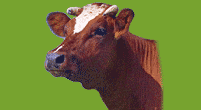
 РАЗВЛЕЧЕНИЯ
РАЗВЛЕЧЕНИЯ ЭКСПЕРИМЕНТЫ
ЭКСПЕРИМЕНТЫ ВЕГА́НСТВО
ВЕГА́НСТВО  МЕХ
МЕХ СОБАКИ и КОШКИ
СОБАКИ и КОШКИ ГУМАННОЕ ОБРАЗОВАНИЕ
ГУМАННОЕ ОБРАЗОВАНИЕ Видео
Видео
 Фото
Фото
 Книги
Книги
 Листовки
Листовки
 Закон
Закон
 НОВОСТИ
НОВОСТИ
 О нас
О нас
 Как помочь?
Как помочь?
 Вестник
Вестник
 СМИ
СМИ
 Ссылки
Ссылки
 ФОРУМ
ФОРУМ
 Контакты
Контакты

 ПОИСК НА САЙТЕ:
ПОИСК НА САЙТЕ:









 ВАЖНО!
ВАЖНО!